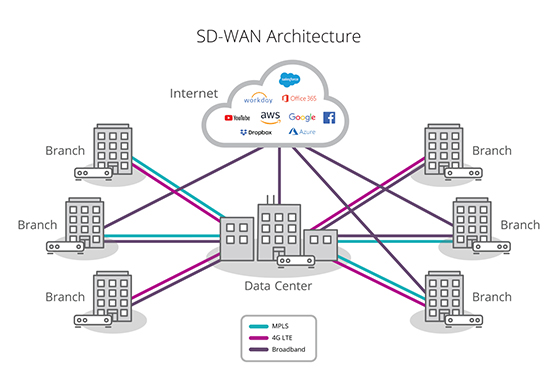it solutions blog
What is SD-WAN?
SD-WAN stands for software-defined wide area network and is a network that is abstracted from its hardware, by software, creating a virtualized network overlay. SD-WAN is essentially a virtual WAN architecture that allows businesses to leverage any combination of transport services – including MPLS, LTE, broadband internet services – to connect users to applications securely.
Why is SD-WAN trending?
Being abstracted from hardware, SD-WAN is more available and can connect several branch locations to a central hub office. While traditional WANs are based on traditional routers, SD-WANs are designed for the cloud, using a centralized control function to securely direct traffic across the WAN. WAN isn’t “cloud ready” and makes it difficult for businesses to scale their IT environment to support remote workers and contractors. The SD-WAN model is designed to fully support applications hosted in on-premise data centers, public or private clouds and SaaS services, while delivering the highest levels of application performance. This centralized control function helps with all traffic, especially cloud traffic, and results in increased business productivity, agility, and reduced cost for IT by increasing application performance, and delivering a high-quality user experience.
As more businesses embrace the benefits of a virtualized network, SD-WAN has been on the climb. An IDC forecast predicted the global SD-WAN market to grow to $5.25 Billion in 2023.

Top benefits of SD-WAN:
- Improved Security, since you can consolidate your network edge infrastructure and manage everything from a single location. Centralizing your security policies removes the human error that comes with configuring edge connections manually. Meanwhile, built-in security, such as next-generation firewalls, protects your data and enterprise at the network edge.
- Increased bandwidth at a much lower cost, since the network traffic can be managed and adjusted for optimal speeds
- Reduced on-site IT staff (more cost savings) since centralized management across branch networks is done through a simple management console, eliminating the need for manual configuration
- Flexible options with connection type and vendor selection, since the network can reside on basic COTS hardware and use both private and public connections to route traffic
Why SD-WAN?
While traditionally, users connected back to the corporate data center to access applications, they are now able to access those same applications in the cloud, as enterprises are moving to the cloud and subscribing to SaaS. As a result, the traditional WAN no longer supports all of the traffic and introduces latency while impairing application performance. SD-WAN on the other hand provides bandwidth efficiency and a seamless on-ramp to the cloud with significant improvements in application performance while not sacrificing security or data privacy.
LEARN MORE
To learn more about SD-WAN or receive a free cost analysis with competitive marketplace pricing, leave your preferred contact information, and have a team member contact you.

